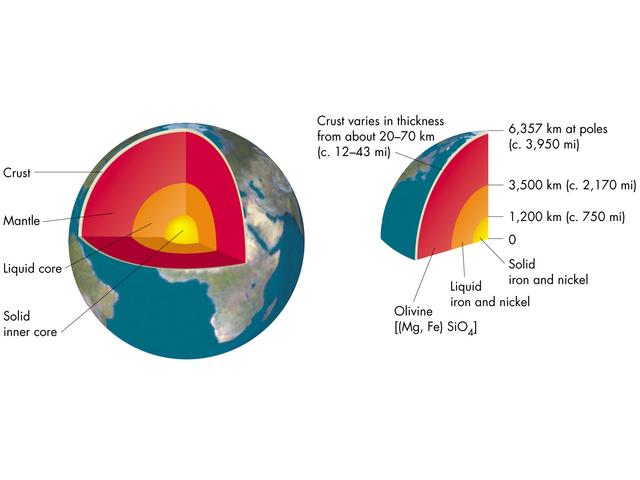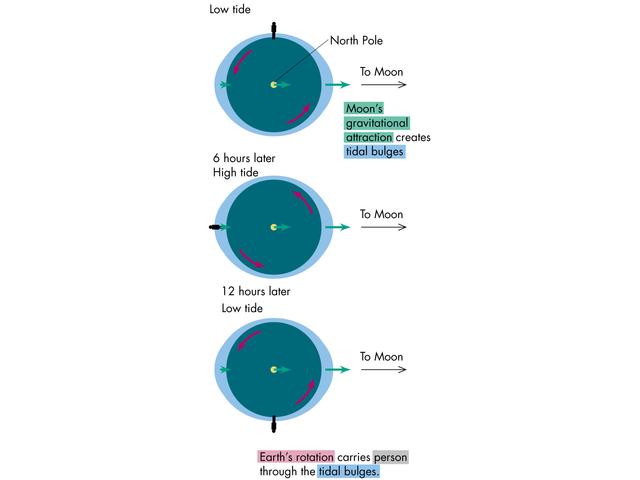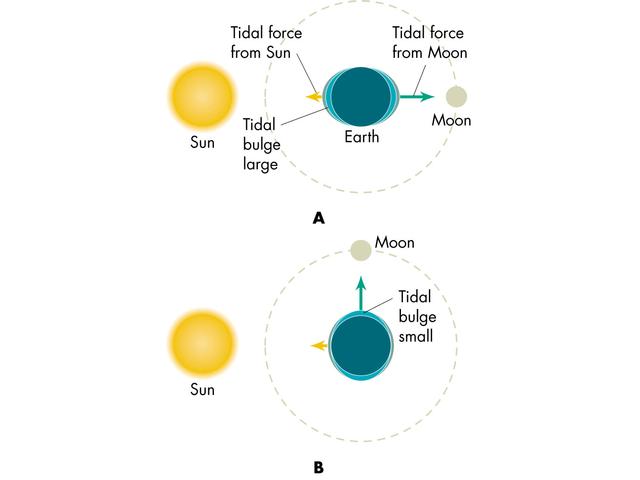
Reading Assignment: Arny Overview III, Chpts. 11, 4, & 6

Chromosphere: Thin layer (104 km). T  104 K (hotter than the photosphere). It's red due to the emission of photons from the electronic transition in Hydrogen from level 3 to level 2 (H-
104 K (hotter than the photosphere). It's red due to the emission of photons from the electronic transition in Hydrogen from level 3 to level 2 (H- = 6563 Å)
= 6563 Å)
Corona: Large, low-density envelope (T  2 x 106 K -- lots of X-rays). Structure due to magnetic field.
2 x 106 K -- lots of X-rays). Structure due to magnetic field.
Solar Wind: electrons and positive ions streaming from the Sun (v  500 km/s). Interacts with the planets' magnetic fields and with comets.
500 km/s). Interacts with the planets' magnetic fields and with comets.
Solar Flare: Violent release of energy from the Sun. (T  5 x 106 !). The matter from these can sometimes collide with Earth causing radio communication disruptions and fantastic auroras.
5 x 106 !). The matter from these can sometimes collide with Earth causing radio communication disruptions and fantastic auroras.
Prominence: more gentle eruption on Sun's surface. Loops of gas following magnetic fields lines above the Chromosphere, glowing red (T  104 K).
104 K).
Sunspots: dark blotches on the photosphere. Appear black or dark grey because they are around 2000 K cooler than their surroundings.

 , and the Temperature, T. It's called the Stefan-Boltzmann Law:
, and the Temperature, T. It's called the Stefan-Boltzmann Law:
 =
=  T4
T4
Where  is the Stefan-Boltzmann constant (
is the Stefan-Boltzmann constant ( = 5.67 x 10-8 W m-2 K-4). So, we can see that for a blackbody emitter a hot object emits much more energy than cold objects per unit area. So this is why the temperature difference between the Sunspots and the surrounding Photosphere makes such a difference in brightness.
= 5.67 x 10-8 W m-2 K-4). So, we can see that for a blackbody emitter a hot object emits much more energy than cold objects per unit area. So this is why the temperature difference between the Sunspots and the surrounding Photosphere makes such a difference in brightness.
Sunspots are regions of strong magnetic fields that inhibit the rise of hot gas from below the photosphere.
Solar Activity Cycle: Sunspots, prominences, and flares are numerous during peaks of an 11 year cycle. Last maximum was in 1990, 2001 is another.


NOTE: The ellipticity of Earth's orbit DOES NOT cause the Seasons. There two simple clues to this:
(A) When it's Summer in the Northern Hemisphere it's Winter in the Southern Hemisphere and vice versa.
(B) Perihelion (Earth's closest approach to the Sun) occurs in December/January, during the Winter of the Northern Hemisphere, and Aphelion (Earth's farthest distance from the Sun) is reached in June/July, during Summer in the northern Hemisphere.
The difference in energy received by the Earth from Aphelion to Perihelion is incredibly small, not enough to cause climatic changes by far.
Back to the REAL cause of the Seasons. First the length of the day. When the Earth's northern hemisphere is titled toward the Sun it is Summer. The Sun rises north of East comes as close as it will ever get to the zenith and then sets north of West. This lengthened path of the Sun leads to days that are longer than 12 hours and the surface in the Northern Hemisphere is heated by the Sun's rays for longer periods of time. The longest day of the year is called the Summer Solstice and it is when the Earth's northern hemisphere is pointing directly at the Sun (June 20th/21st). 3 months later the Earth is a quarter of the way around the Sun and the Sun rises closer to East, and sets closer to West and takes a lower path through the sky. On the Equinox (September 21st) the Sun rises exactly in the East and sets exactly in the West. The day is 12 hours long and so is the night. Then 3 months later, the Sun reaches its lowest point in the sky and rises and sets from its most southernly spot. This is the Winter Solstice (December 21st), it is the shortest day of the year and the Earth is not heated for very long allowing the temperatures to get colder. 3 Months later the Sun again rises in the East and sets in the West on the Vernal Equinox (March 21st) and the day is again 12 hours and so is the night.
Secondly, when the northern hemisphere is pointed at the Sun a beam of its light falls across a given area, A. That area receives all the photons in that beam. 6 months later when the northern hemisphere is pointed away from the Sun the same beam of light will fall over a greater area, B. So area A receives fewer photons than it did in Summer, and so is heated less in winter than in summer.
Internal Structure:

The crust is divided into plates that move as the Mantle circulates with convection. The intersections of these plates are places where geologic activity is greatest: mountains, volcanos, earthquakes, etc..
The Surface:
75% of the surface of Earth is covered in oceans of liquid water. The oceans are kilometers deep. The continents are lighter parts of the crust that rise above the oceans. The surface is covered with living organisms that greatly affect and change the environment of the surface (biosphere).
The Atmosphere:
The Earth's atmosphere is very thin (< 100 km.) It is composed of 79% Nitrogen and 20% Oxygen and smaller amounts of other gases (Carbon Dioxode, etc.). Oxygen is a highly reactive chemical and is quickly used up unless constantly replienished. Plant life on Earth creates the oxygen from photosynthesis.
The Magnetosphere:
The molten interior of Earth is charged and as it circulates it creates a magnetic field. It looks like the field of a bar magnet ("dipole"). The North and South Magnetic poles are not always aligned with the North and South Geographic poles. The sometimes switch and wander about the surface (~ 50,000 years).
Charged particles in the Solar Wind get trapped in the magnetic field and are channeled toward the poles where they crash into the atmosphere. When they do they excite the electrons in the atoms and molecules in the atmosphere which then cascade back down releasing photons and create the Northern and Southern Lights (Aurorae).

Tides:
Because the force of gravity is weaker with increasing distance the gravitational pull an extended object will feel will be different across its length. This differential gravity is called a tidal force. The Moon exerts a differential pull on Earth and this is the cause of the tides on Earth. The side closest to Earth is accelerated toward the Moon the most, the center a little bit less, and the far side of Earth less still. This causes the shape of Earth to be squished out like a football.

The Sun also contributes to this, but the Sun's tidal distortion on Earth is half that of the Moon's because of its distance. The maximum tides occur when the Earth, Sun, and Moon are all in a line (new and full Moon). The minimum tides occur when the Moon is in either quarter phase.

This process causes a kind of friction that slows the Earth's spin. In doing so Angular momentum must be conserved and so the Moon's orbital angular momentum increases and it moves farther away. This friction is a kind of energy loss of the system. The energy loss continues until a minimum amount of friction is present. The Moon was likely spinning faster on its axis, but the Tides raised on it surface by Earth slowed it into lock-step with its orbit. This is called orbital resonance. It is a minimum energy loss state. The Earth will one day reach a similar state. Then the day will be as long as a month, which will also be longer than the current month because the Moon will be farther away. The Moon's angular size in the sky will be smaller and there'll be no more total solar eclipses. Also Earth will show only one face to the Moon just as the Moon currently does to Earth.
The Moon:
Since the Moon rotates only once per orbit about the Earth that means that it also experiences a solar day equal to about 29 Earth days. So the Sun is in the sky for 15 days. There is no atmosphere on the Moon, so the temperature goes through great extremes: -110°C (night) to 130°C (day)!
The Moon is heavily cratered due to impacts. The most heavily cratered spots are the oldest. Lava flows produced Maria: covered the surface.
There's very little erosion on the Moon: so you can get relative ages of features by comparing the amount of cratering (ie, craters on maria are younger than the maria). You can then derive absolute ages of rocks (since last molten anyway) by radioactive dating of the Moon rocks brought back by the Apollo astronauts. The heavily cratered areas: 3.9 - 4.4 Billion years old, Maria: 3.1 - 3.9 Billion years old.
There are few craters on the maria; hence, the bombardment of the Moon must have happened very early after the formation of the Solar System. Earth is a bigger target, if the Moon was getting pelted that much you can believe that Earth was taking a worse beating.
Earth-Moon system is practically a double planet. The Moon is quite large. It probably coalesced from debris ejected by a collision of a Mars-sized object with Earth, early in the History of the Solar System.
Return to Class Notes Page